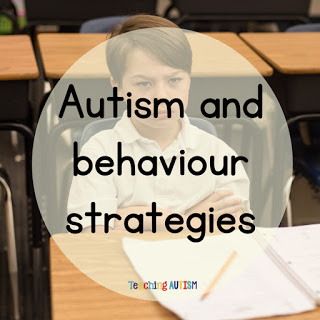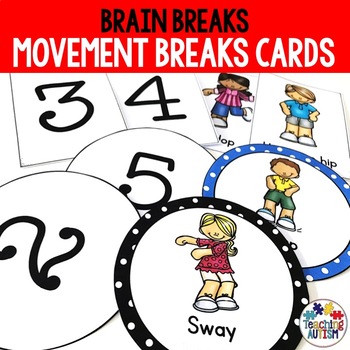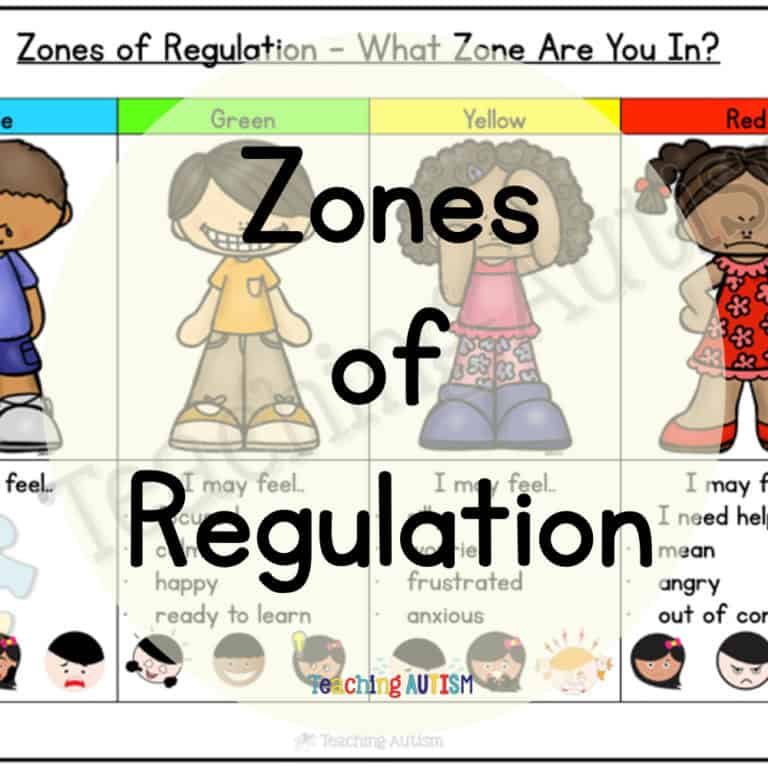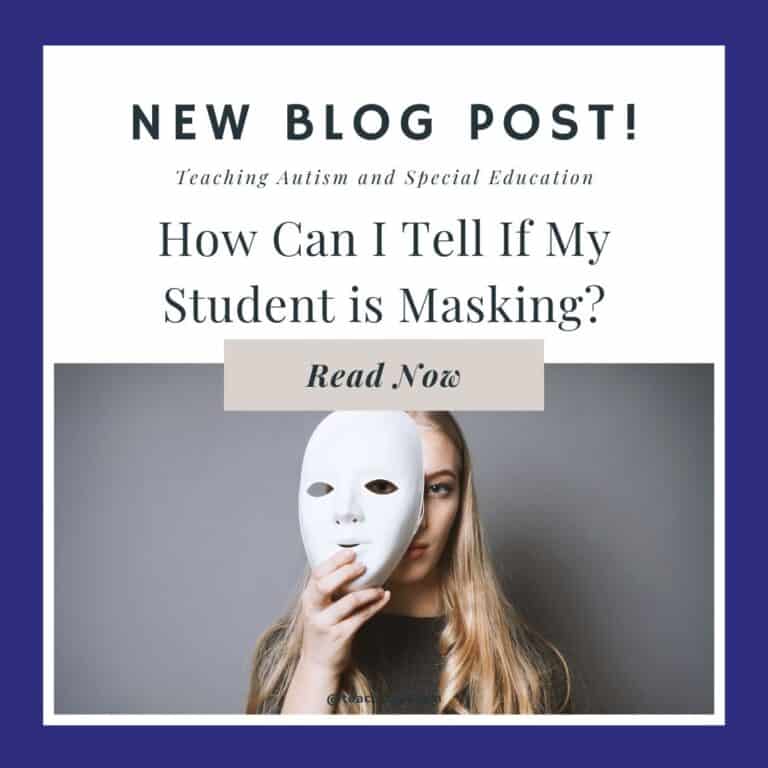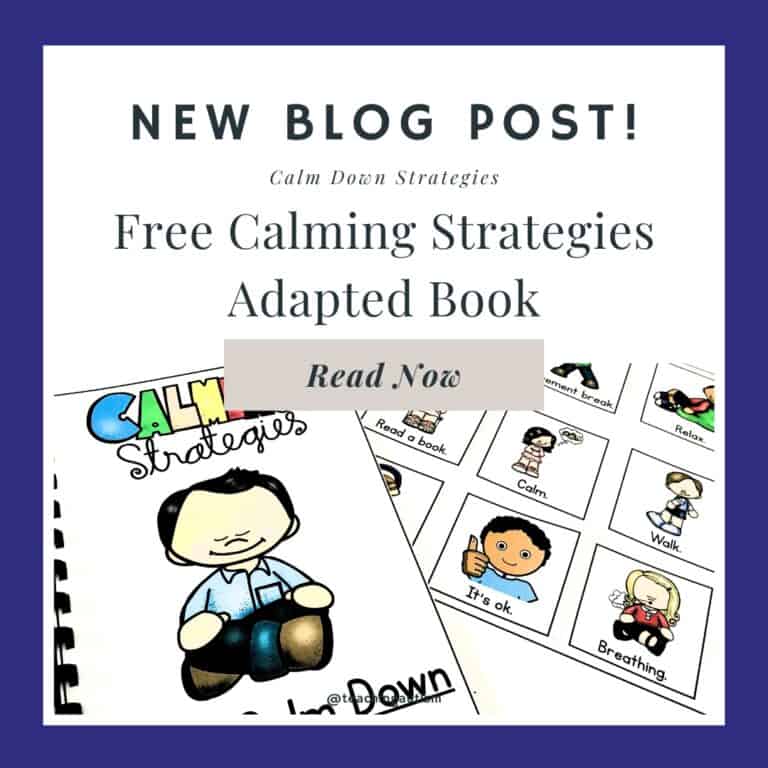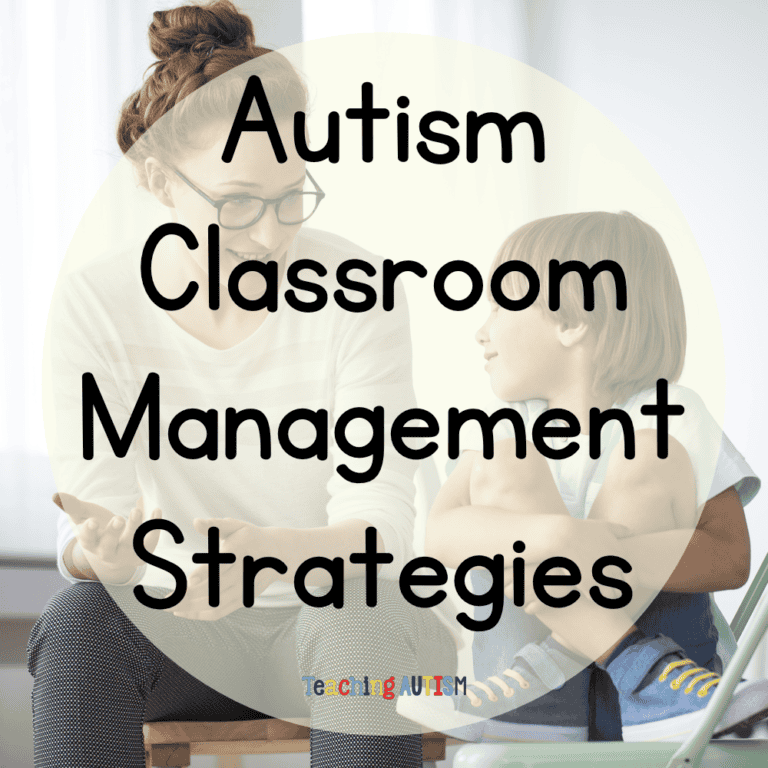Autism Behaviour Strategies for School & Home
Today I want to talk to you all about autism behaviour strategies for school and home. As you will know, all of our students and children are different. And that means their behaviours are different as well.
Now, behaviour is a difficult one. Because every behaviour has a function. And it’s pretty much impossible to start putting strategies into place to help a behaviour, if you don’t know what the function is. And the function, is basically the reason why the individual is behaving that way.
So, first of all, make sure that you do your best to try and find the function of the behaviour before deciding what strategies to put into place. Today, I wanted to share some strategies for behaviour management that have worked well for me and my students over the years. And I will be so pleased if they help you out too.
Triggers
You may think that our students display behaviours without any triggers or causes. But 99% of the time – there’s definitely a trigger or reason why they have exhibited this behaviour. And you are going to have to look from every different angle to try and find what the trigger is for your student.
Some examples of triggers that can cause behaviours are;
- Loud noises
- New surroundings
- Transition
- Other children in their space
- Work
- Escape/Avoidance
and those are just a few examples. There are thousands of triggers that could be causing behaviours for your students.
How Do I Know a Behaviour is Coming?
All of our students will have different signs to show that they are feeling unsettled, distressed or that they are about to display challenging behaviours.
Some examples are;
- Playing with their hair
- Clicking their fingers
- Tapping their feet
- Eye movement
- Breathing
- Non-verbal noises
- Pacing
and there are so many other signs they may display as well. This is why I always say to spend time at the start of every year getting to know your students. By getting to know your students – you’ll know what their tell-tale signs are. And this is when you can intervene and help support them before a behaviour happens.
How to Help
I had a teacher reach out to me recently to ask for support about one of their students. They had managed to work out that the main trigger for this students behaviour was going out on a trip. But, they couldn’t figure out why. Because, once they were out on the trip – they were so happy! But the behaviours were very challenging that morning.
So, we sat down and we talked through some things that may be the trigger for this particular student. And we came up with;
- Transition. Has he completed what he was doing before moving onto going out for the trip?
- Safe place. School is a safe place for this student. Is it stressful when he’s leaving?
- Unknown. Does he know where he’s going? Has he been told what’s happening? The unknown can be very scary.
- Surrounding people. Who is this student going with? Is he going to be paired with someone that upsets him? Did he want to go with someone else? Is there a particular member of staff that he doesn’t want to be with. Or that he does really want to be with.
- Missing out. Yep. The fear of missing out. What’s going on in school prior to leaving for the school trip? Is there something exciting going on somewhere else? Does he think he’s going to miss out on something by not going?
So, as you can see, there are so many reasons for one behaviour. And I could give 10-15 different strategies for each one. Which is why it’s important to find the function of the behaviour, before putting strategies into place. Otherwise, you could end up like a deer in headlights, trying different things and making no progress.
Re-evaluate and Reflect
After there’s been a challenging behaviour, you need to take time to reflect. Sit down with the staff members in your team. How did the behaviour happen? What were the triggers? Did anyone notice anything that happened just before the behaviour? How did they calm down? Did anything work well? What didn’t work well? Or what can you change or try next time?
If something didn’t work, don’t stress. Sit down and re-evaluate. That strategy didn’t work, but we noticed XYZ so next time we will try……….
And don’t be afraid to invite someone else into the conversation, like a behaviour specialist, or someone from another class. Sometimes, an outside head and pair of eyes can see things we miss. We spend so long studying behaviours, that we might miss something. So this is a good opportunity to invite someone else in.
Asking the Student
If it’s appropriate, you can ask the student about their behaviour as well. What happened? Did something upset them? How do they feel now? This isn’t always the best strategy. And it won’t work for many students. But, it may work for your one student.
Visuals
Visuals are a fantastic way to communicate with our students. If a student is displaying challenging behaviours, they probably can’t hear what you’re saying. Or they can’t process what you’re saying to them. So visuals can help to visually show the student what you’re saying. These can also help the student to know what is coming next. Or what their behaviour consequences are. It could even show them choices of how they’d like to calm down – or what do they need from you.
Traffic Light Systems
Traffic light systems are a great way for students to visually see their behaviour. Some students really like this system, but others don’t. Green is the best place to be. Amber is a small warning. Red is known for us as ‘oh no’ – this is what my students have opted to call it. We try not to use negative words about behaviours, we’re all about positive reinforcement. So, on red, we always used to say ‘Oh no, we need 5 minutes, let’s go’ and we’ll go for a walk, to the sensory room, read a story. Anything to help them calm down.
Green for us is when the children are being good – and obviously you have to remember that some things are just ‘autism’ you can’t move a child to amber for flapping their hands for example, it’s not a behaviour, it’s the individual. Amber for us means they’re on their warning, red means final warning and there’s some sort of repercussion – it could be having to sit with a timer, moving to the calm down area, sitting with an adult for a social story etc.
First and Then System
The first and then system is a great way for students to know what is happening in close timing. So, first I am going to work. And then I am going to get my reward. You can also cater them to different levels like ‘First and then’ ‘First, Next and Then’ etc. all depending on the ability level of student.
Visual Schedules
Visual schedules are a great way for students to know what is happening throughout the day. This helps to avoid the unknown. Which is helpful for many students. Being able to see what’s happening and when throughout the day. This avoids the questions of ‘When?’ throughout the day.
You can use visual schedules for the whole class using one large schedule. Or you can have individual schedules for each of your students.
Working For Reward System
This is one of my favourite systems to use with my students. They respond really well to it. And it can be differentiated to suit different levels and how much work you want your students to complete before they get their reward.
This also gives your students a sense of control where they can choose the reward that they receive once they have finished their work.
One thing here, is that I never take away tokens from my students. I’ve always been of the belief where if a student works hard and achieves a token, then they get to keep it. By taking away that token, I just feel like it’s telling my student no matter how good they were, when they displayed a negative behaviour, they lose everything. And this can have a negative affect on the students mindset.
You can have your students achieve tokens by completing each work activity, or completing set time periods of work.
Timers
I love timers. I honestly believe that every classroom in the world should have visual timers. And that’s not just general education classrooms either. Everyone benefits from a visual representation of how much time they have left.
You can use timers for a range of different reasons and situations;
- Sharing. Many of our students can find it difficult to share or take turns. Having a timer shows them how long they have left of their turn. Or how long they have to wait until it’s their turn next.
- Calming down. Sometimes, we all just need a few minutes to cool down and move away from a situation. By having a visual timer, your students can see how much time they have to cool themselves down before returning.
- Work. There’s nothing worse than having work in front of you and not knowing how long you’re going to be working for. Having a timer in front of you, shows you how much longer you’ve got left to complete it. Especially if your student feels like they need to finish an activity before transitioning to the next activity. Or during choice activities.
- Pre-Work. You know how you can be sat enjoying yourself, and then someone comes and takes that away from you? No, probably not. Because you have a concept of time. And you know how much time you have left until the next time you have to work. Your students probably don’t have this. But, by providing them with a visual timer – they can see the time going by and how much longer they have left.
Boundaries
It is really important for you to set clear boundaries in your classroom. Boundaries are important to help us function in day to day life. And not just for our students – but for adults too. It is important that we show our students how far they can go, what they can do and what they can’t do. I feel like it’s very important to teach generic boundaries – because this is what will happen in real life. You can’t teach them it’s ok to take food off everyone’s plate in the house, then get mad if they try to take food off a strangers plate in a restaurant. Because you’ve not provided them with clear boundaries.
Understanding rules can be difficult for our students. So there’s a few ways you can show them. You can have a visual book to work through the classroom rules. Or you can have social stories to help your students understand in a more visual and appealing way. Many of our students find it easier to understand boundaries when colour visual cues are used. For example red is a deterrent – something they aren’t allowed to touch/use, for example an oven door, the iron etc.
Consistency
Consistency is key. You need to be consistent with your students. And that means all members of staff being on the same page as well. Things can quickly become confusing for your students if everyone isn’t being consistent with the rules. And this is especially true for behaviour management. And this means at home and school as well.
For example, let’s do a quick example case study on Johnny.
Johnny is 6 years old. His mother and father have separated. Johnny spends 1 week with his mother, then the next week with his father etc. He goes to school Monday to Friday. And every Thursday afternoon he goes out with a respite worker.
Johnny’s main challenging behaviour is spitting on the floor. His mother refuses to let him spit. She gives him a verbal warning and reads him social stories if he spits to show him it’s not allowed and rude. Dad uses planned ignoring and refuses to acknowledge when Johnny is spitting because he thinks the function is seeking behaviour. Johnny’s school direct him to spit down the sink and wash it away if he needs to spit. But, his respite worker takes a different approach again. She takes Johnny to all his favourite places, cafes, shopping, soft play areas. But if he spits, she takes him straight home.
So, looking at this case study. What do you think Johnny thinks will happen to him when he spits? He probably doesn’t really know. Because everyone is reacting in a different way to the spitting. It’s confusing for him.
The best thing to do, is have everyone sit down together for a meeting. And everyone discusses the behaviour. And then move forward, how can you all deal with this behaviour? What’s the best way to deal with it? And everyone agrees on the same strategy to handle this behaviour. That will provide a more consistent approach across the board with Johnny.
When everyone sat down, they discussed the function of the behaviour. Why does Johnny spit? What happens before he needs to spit? Finally, after a long discussion. They came to the conclusion that him spitting, could be down to the taste in his mouth after he’s eaten. And this was usually after spicy foods. So everyone put a plan together. And when Johnny feels like he needs to spit, he can use a mouthwash symbol. He goes to the bathroom and uses mouthwash. Everyone involved with Johnny has the same approach. And this has made Johnny more independent in managing his behaviour too.
Planned Ignoring
Planned ignoring can be a great strategy to use for behaviours where the child is seeking attention for a reaction. A lot of the times we use planned ignoring for small behaviours. This could be dropping themselves on the floor – where they are not a danger to themselves or others – when they don’t want to work. Sometimes, planned ignoring and positive reinforcement of others in the class who are completing the work can be the encouragement the student needs to come back to task.
Movement Breaks
Have you ever had to sit on a long haul flight? If so, you probably know how horrible it is to be sat in just one position. You want to get up and walk around. And this is the same for our students in the classroom. If they are sat for a period of time at their desk working, they’re going to get bored. And they’re going to start to lose concentration and attention. And when this happens, that’s when behaviours can start.
I always recommend having short movement breaks throughout the day. And we love to use our movement break cards.
Time and Space
Let’s face it, sometimes we can all do with a little bit of time and space to ourselves. We all get days when we feel a little more stressed. Or we’ve woken up on the wrong side of the bed. And the overwhelming pressure on us is getting too much. Sometimes, comfort from others can help. But, other times it can be too much. And we don’t want that comfort. We just want time and space to ourselves.
This is again why it’s important to get to know your students. Because you’ll be able to look for signs that show you if they want comfort or if they need time and space to calm themselves down.
Physical – Punch bag etc.
A lot of the time our students find it very difficult to get all of their frustrations and anger out of their system. This can all build and build. Then, finally, they might end up bursting and letting it all out at once. We’ve had some success with physical behaviour strategies where our students can release that tension. Some examples are;
- Boxing session. Yup. We actually have had boxing sessions. Now, these aren’t full on professional ones like you’d sign up for as an adult. But, we’ve followed simplified boxing moves. We’ve worn boxing gloves to punch thin air. They have a lot of fun and it’s a great way to get them moving, active and releasing some tension.
- Punch bags. A punch bag isn’t anyone else – it can’t be harmed. It doesn’t have feelings. And this is the perfect opportunity for your students to release tension. The punch bag provides your students with the opportunity to lash out without hurting themselves or anyone else.
- Push wall. This is actually one of our favourite behaviour strategies. A push wall is literally what it sounds like. We print out clipart hands and we put them onto the wall. When students need to release tension, they go over to the push wall. They put their hands on the clipart hands and push real hard.
- Movement breaks. Again, as stated above, these are a great way to get your students moving around.
Cool Down Area
We’ve discussed in one of my previous blog posts about how beneficial a cool down area can be. And you can read about that here. A cool down area can provide students with a safe space. And this is where they know they can go in order to calm down independently in a calm and relaxing environment. It also provides them with the time and space they may need.
Multi-Sensory Room
Multi-sensory rooms are a huge hit with many of our students. The only downside is that they can be very expensive to put together if you don’t have one already. Although, there are some great DIY ideas on Pinterest that you can use for a much more affordable price. These rooms help to provide a calming atmosphere to help your students relax.
Sensory Approach
There are many sensory techniques that are popular with our students to help them calm down. One of our favourite sensory techniques to use are sensory stories. And you can listen to our podcast episode here where we talk all about sensory stories.
Story massage is also another great sensory technique to use with your students. We’ve even had story massages completed on ourselves in the classroom so that we can feel what our students experience when we use this sensory technique.
Use Less Verbal
Sometimes, we can forget who we are talking to. And how much we are saying. And when our students are in a heightened state, or displaying challenging behaviours, this is not helpful. Imagine you were feeling anxious or worked up and someone was constantly talking to you. Are you going to be able to hear what they’re saying? Can you take in everything they are saying? Probably not! You could be telling them what to do and what consequences will happen if they don’t – but they’re probably not even hearing this. And they probably can’t even process what you’re saying.
Patience
You are going to need a LOT of patience when dealing with challenging behaviours. You’re going to feel mentally and physically drained. And sometimes this can affect how you react to certain situations. If you feel like you need a break, that’s ok. Swap with another member of staff. There’s nothing wrong with holding your hands up and saying you aren’t the person to deal with this right now.
Positive Reinforcement
This is really important. You need to ensure that you are praising good behaviours. Because this helps to reinforce those positive behaviours. And that will help your students understand how positive it was – and to repeat those behaviours in the future.
Relaxation
It’s important that we provide opportunities for our students to relax throughout the day. School can be a stressful environment for our students. So it’s important for us to try and provide as many opportunities as possible to help them relax. This could be as simple as a sensory story. Or having time to relax on the bean bags in the multi-sensory room. You can even try out Touch Trust. And this has worked really well for us in the past.
Role Model
Remember that you are a role model for your students. You and your staff should be leading by example. Your students are always watching you. And how you behave and react to situations. If you get stressed or anxious, your students will probably pick up on this. And that can affect their behaviour too.
Also, you can’t tell your students not to do something – and then you go and do it. Rules are rules. And they are for everyone to follow. At the start of the school year, ensure all your staff members know what your rules are. And spend time those first few weeks of school talking about these rules. And helping your students fo follow them. Spending that time at the start of the year can be very beneficial for the rest of the year running smoothly.
Social Stories
I LOVE to use social stories with my students. They provide a visual support system for my students. And my students really benefit from visually seeing what is being said. It helps them to understand it better. And you can have social stories for almost every situation or behaviour.


For behaviours, social stories can show the reader what to do in different situations. And give them choices.
Pick Your Battles
I kept this one for last because this is a very important one. It is very easy to get caught up in a power struggle with our students. And you have to be able to hold your hands up and say enough is enough and walk away from the power struggle. Nobody wins in a power struggle. Tell the student, that is your final decision and walk away. Don’t re-engage.
Picking your battles is literally as it sounds. Choose what you’re going to work on with your students. You can’t work on everything all at once. Is what you’re choosing vital for your student? Is it important for you to get that right now? Yes, ok work on it. No? That’s ok. Work on the more important things now. And we can come back to this in the future!
What are some of your best behaviour management strategies that you use with your students? Let us know in the comments below.
And if you found these behaviour management strategies helpful, please consider sharing them with your friends, family and coworkers.
Nikki


